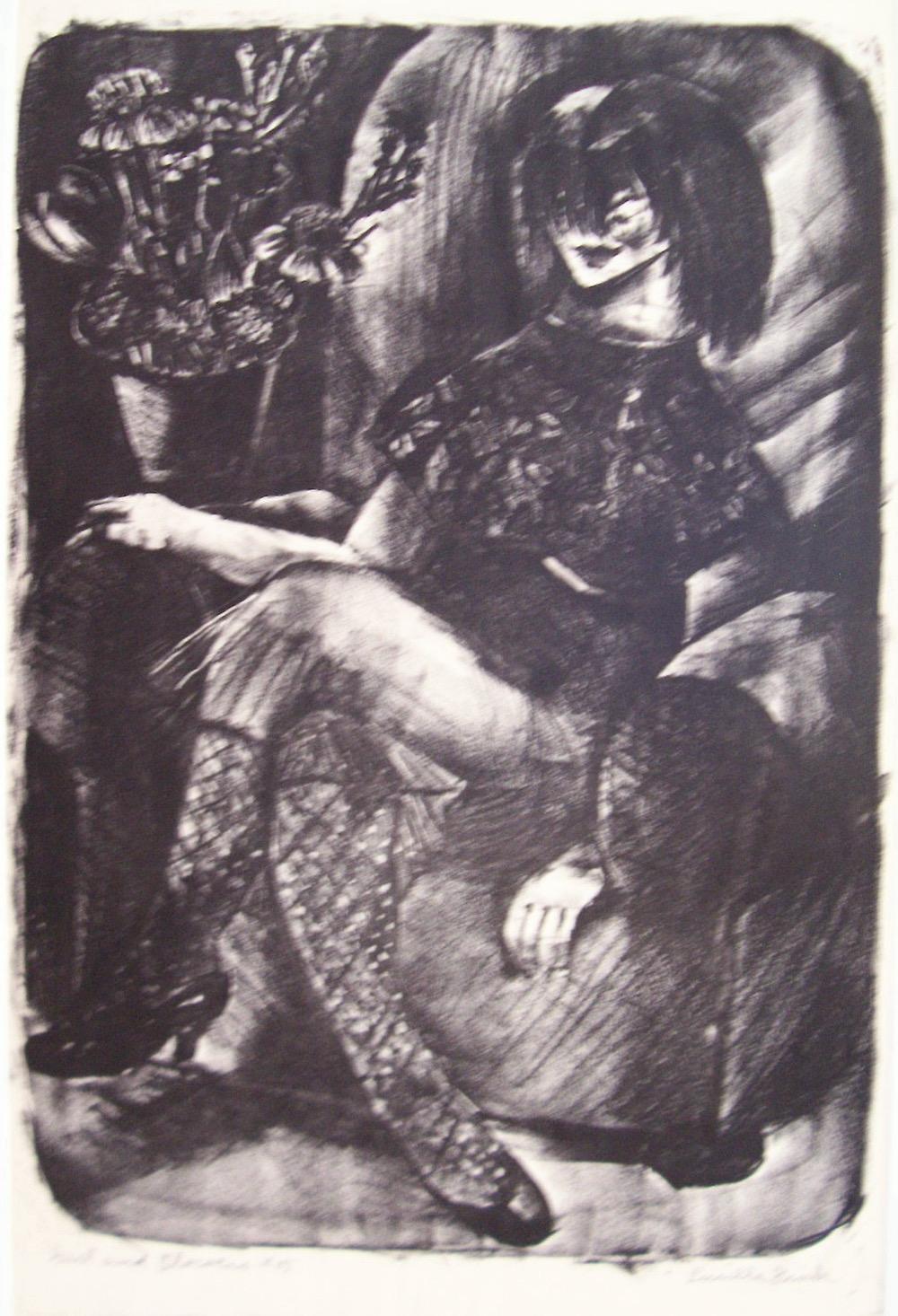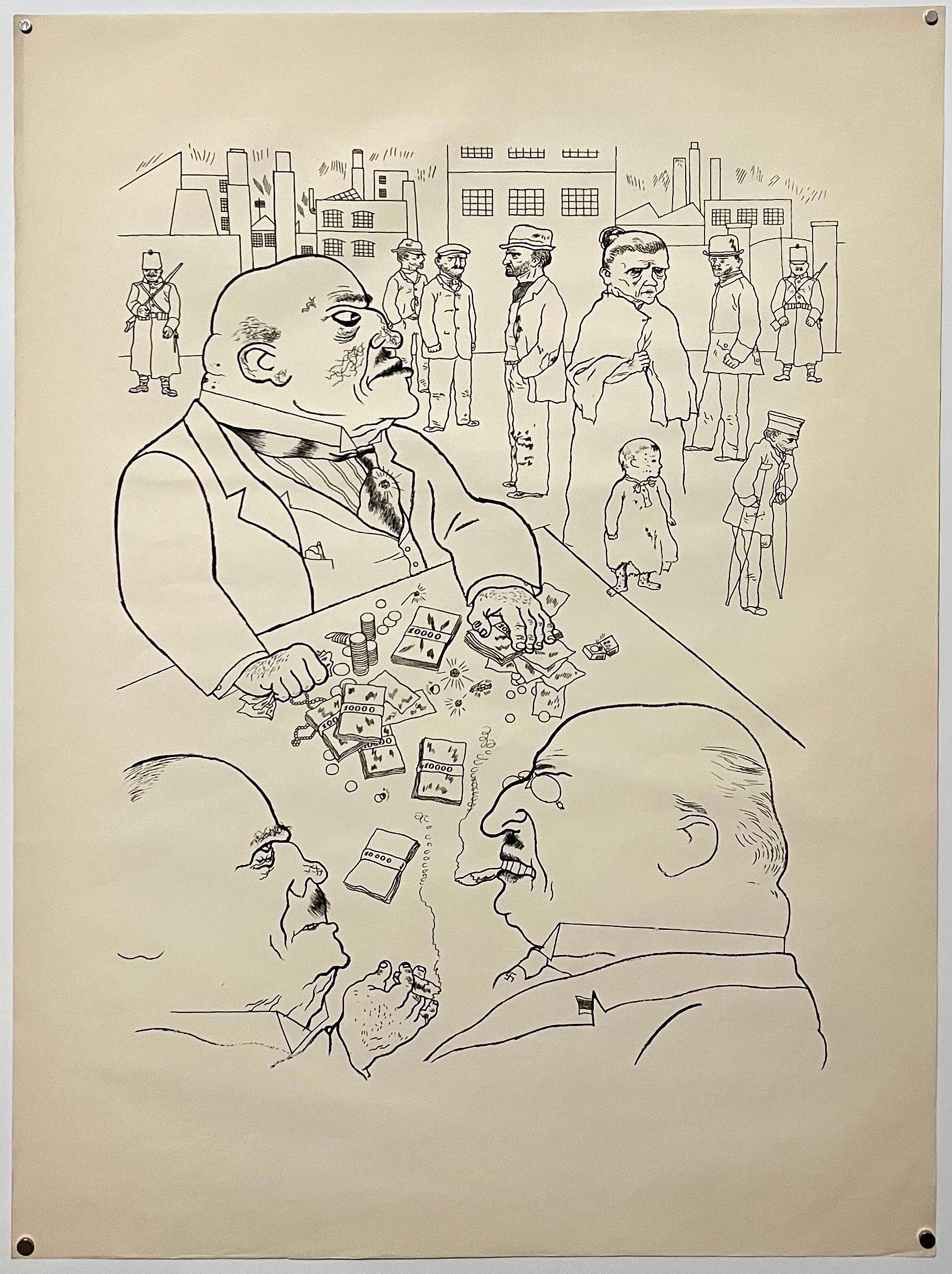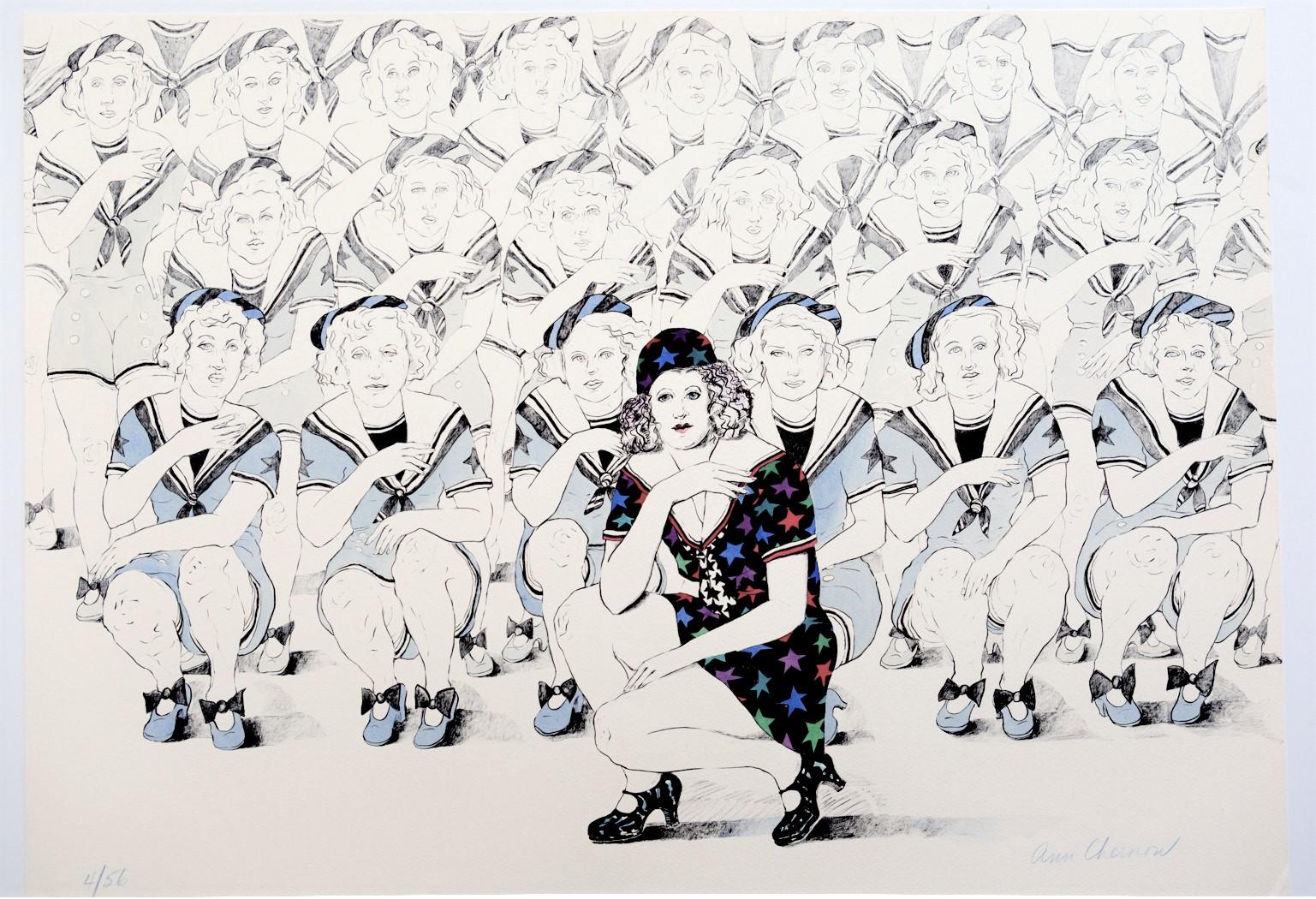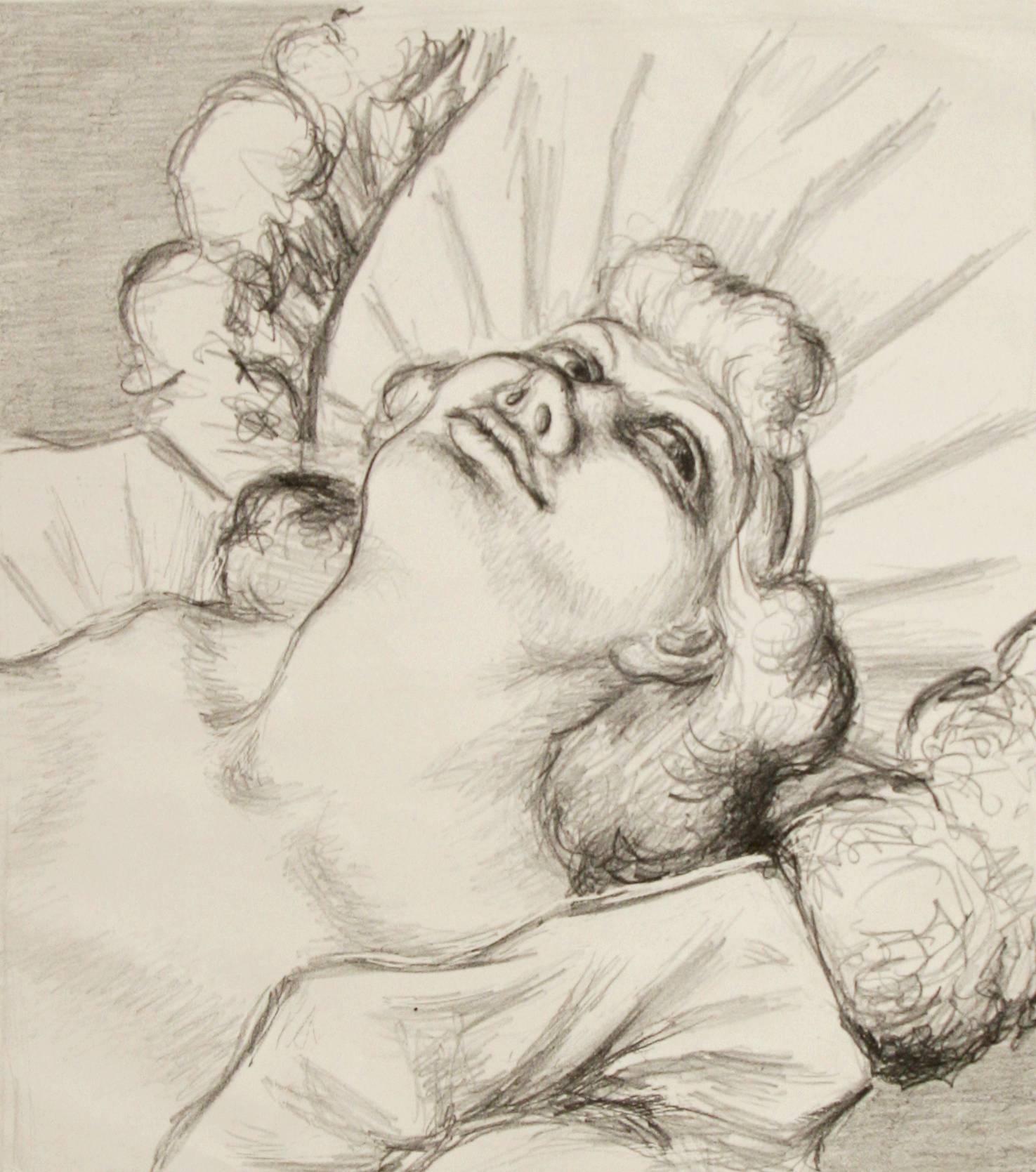Items Similar to Large George Grosz 1923 Lithograph Die Rauber German Expressionism WPA Realism
Want more images or videos?
Request additional images or videos from the seller
1 of 20
George GroszLarge George Grosz 1923 Lithograph Die Rauber German Expressionism WPA Realism 1922-1923
1922-1923
About the Item
From The robbers. lithographs by George Grosz for the drama of the same name.
photolithography on watermarked paper. 19 X 25.5 inches (sheet size). This is not hand signed or numbered in pecil.
Limited edition. Berlin, Malik-Verlag, 1923.
Dückers MV, 1-9
This listing is just for the one lithograph, the folio cover photos are just included for provenance and is not included in this sale.
The portfolio is based on pen and ink drawings that were transferred using photolithography for printing. Schiller's "Räuber" served as a template, which Grosz transferred to his time and updated with drawings. With sharp polemics, he brings together the types of society and draws attention to social grievances: Financial disparity, robber barons with piles of money etc. according to the military chaplain, who blesses the disaster of war that has already happened; the well-fed manufacturers who gamble in the presence of the unemployed for the money they lack; or the hollow-faced creature begging a bounty from the richly set table of the bronze.
Expressionismus Grosz, George
Die Räuber: Neun Lithographien zu Sentenzen aus Schillers Räuber. Lithographien von George Grosz. Berlin, Der Malik-Verlag, 1922.
George Grosz (July 26, 1893 – July 6, 1959) was a German artist known especially for his Satire and Caricature drawings of Berlin life in the 1920s. He was a prominent member of the Berlin Dada and New Objectivity group during the Weimar Republic before he emigrated to the United States in 1933. He studied at the Dresden Academy of Fine Arts, where his teachers were Richard Müller, Robert Sterl, and Oskar Schindler. He subsequently studied at the Berlin College of Arts and Crafts under Emil Orlik. Grosz left the Communist Party KPD in 1922 after having spent five months in Russia and meeting Lenin and Trotsky, because of his antagonism to any form of dictatorial authority. Along with Otto Dix, he is widely considered one of the most important artists of the Neue Sachlichkeit.
Bitterly anti Nazi, Grosz left Germany shortly before Hitler came to power. In June 1932, he accepted an invitation to teach the summer semester at the Art Students League of New York. In October 1932, Grosz returned to Germany, but on January 12, 1933 he and his family emigrated to America.
In 1946 he published his autobiography, A Little Yes and a Big No. In the 1950s he opened a private art school at his home and also worked as Artist in Residence at the Des Moines Art Center. Grosz was elected into the National Academy of Design as an Associate Academician in 1950. In 1954 he was elected to the American Academy of Arts and Letters.
Grosz worked in a style influenced by Expressionism and Futurism, as well as by popular illustration, graffiti, and children's drawings.The City (1916–17) was the first of his many paintings of the modern urban scene. Other examples include the apocalyptic Explosion (1917), Metropolis (1917), and The Funeral, a 1918 painting depicting a mad funeral procession.
In his drawings, usually in pen and ink which he sometimes developed further with watercolor, Grosz did much to create the image most have of Berlin and the Weimar Republic in the 1920s. Corpulent businessmen, wounded soldiers, prostitutes, sex crimes and orgies were his great subjects His draftsmanship was excellent although the works for which he is best known adopt a deliberately crude form of caricature. His oeuvre includes a few absurdist works, and also includes a number of erotic artworks. ("Ecce Homo" which saw him accused of pornography)
My Drawings expressed my despair, hate and disillusionment, I drew drunkards; puking men; men with clenched fists cursing at the moon. ... I drew a man, face filled with fright, washing blood from his hands ... I drew lonely little men fleeing madly through empty streets. I drew a cross-section of tenement house: through one window could be seen a man attacking his wife; through another, two people making love; from a third hung a suicide with body covered by swarming flies. I drew soldiers without noses; war cripples with crustacean-like steel arms; two medical soldiers putting a violent infantryman into a strait-jacket made of a horse blanket ... I drew a skeleton dressed as a recruit being examined for military duty. I also wrote poetry. —Grosz In 1940 the Museum of Modern Art in New York shows a retrospective of his work which later tours through the United States. In 1946, the AAA Gallery, New York hosts an exhibition titled A Piece of My World in a World without Peace. Later the Dallas Museum of Arts shows several works by Grosz titled Impressions of Dallas and also the Whitney Museum, New York shows retrospective works.
George Grosz's art influenced other New Objectivity artists such as Heinrich Maria Davringhausen, Anton Räderscheidt, and Georg Scholz. In the United States, the artists influenced by his work included the social realists Ben Shahn and William Gropper.
- Creator:George Grosz (1891-1969, German)
- Creation Year:1922-1923
- Dimensions:Height: 25.5 in (64.77 cm)Width: 19 in (48.26 cm)
- Medium:
- Movement & Style:
- Period:
- Condition:good, minor wear. please see photos.
- Gallery Location:Surfside, FL
- Reference Number:1stDibs: LU38212492092
About the Seller
4.9
Platinum Seller
These expertly vetted sellers are 1stDibs' most experienced sellers and are rated highest by our customers.
Established in 1995
1stDibs seller since 2014
1,541 sales on 1stDibs
Typical response time: 1 hour
- ShippingRetrieving quote...Ships From: Surfside, FL
- Return PolicyA return for this item may be initiated within 3 days of delivery.
More From This SellerView All
- Large George Grosz 1923 Lithograph Die Rauber German Expressionism WPA RealismBy George GroszLocated in Surfside, FLFrom The robbers. lithographs by George Grosz for the drama of the same name. photolithography on watermarked paper. 19 X 25.5 inches (sheet size). This is not hand signed or numbe...Category
1930s American Modern Figurative Prints
MaterialsLithograph
- Large George Grosz 1923 Lithograph Die Rauber German Expressionism WPA RealismBy George GroszLocated in Surfside, FLFrom The robbers. lithographs by George Grosz for the drama of the same name. photolithography on laid paper. 19 X 25.5 inches (sheet size). This is not hand signed or numbered in ...Category
1930s American Modern Figurative Prints
MaterialsLithograph
- 1970s Pop Art "Dancing Lessons #2" Silver Silkscreen Mod Ballet Girl PrintBy Joanne SeltzerLocated in Surfside, FLPrinted on a slightly reflective metallic silver finished paper. there is a companion piece on a money green paper. A depiction of a ballet dancer, superimposed upon canceled dance c...Category
1970s American Modern Portrait Prints
MaterialsScreen
- Pulitzer Prize Winner Norman Mailer Portrait Etching Line DrawingBy Knox MartinLocated in Surfside, FLSigned. Numbered line etching Norman Kingsley Mailer (January 31, 1923 – November 10, 2007) was an American novelist, journalist, essayist, playwright, film-maker, actor, and libera...Category
1970s American Modern Figurative Prints
MaterialsEtching
- 1959 Israeli Yosl Bergner Modernist Color Woodcut Woodblock PrintBy Yosl BergnerLocated in Surfside, FLAbstract Composition, 1959 Silkscreen Lithograph "Phoenix". This was from a portfolio which included works by Yosl Bergner, Menashe Kadishman, Yosef Zaritsky, Aharon Kahana, Jacob Wexler, Moshe Tamir and Michael Gross. Bergner, Yosl (Vladimir Jossif) (b Vienna, 13 Oct 1920). surrealist, surrealism. belongs to the generation of people uprooted from childhood landscapes and forced by circumstance to build a life elsewhere. Uniquely, he became an Israeli without shedding his Jewish cosmopolitan-refugee identity, an identity he zealously guarded in the melting pot of Israel of the "fifties" and "sixties". In the years that have passed since he acquired his art education at the Melbourne National Gallery Art School in Australia, concepts in the art world have changed many times over. from the Jewish paintings and the depictions of Australian Aborigines through the children of safed, the wall paintings, the masks, the angels and kings, the still lifes, the "Surrealistic" paintings, the toys and flowers, the paintings inspired by the Bird-head Haggada, the Kafka paintings, the Pioneers, the Kimberley fantasy (about his father's excursion in 1933 to northern Australia, in search of a "territory for the Jews"), Brighton Beach and the seascapes inspired by Eugene Boudin, through the chairs in the "Kings of Nissim Aloni" episode to the "Zionists" and the recent "Tahies". "During the six years that Bergner has lived in Israel," wrote Eugene KoIb, Direct. or of the Tel Aviv Museum, in the catalog of the Bergner exhibit in 1957, "he has established himself among Israeli artists." Bergner was indeed one of the artists who represented Israel in the Venice Biennial (1956; 1958) and in the Sao Paulo Biennial in 1957; this, in spite of the fact that Yosl Bergner did not harness his art to serve the Zionist ethos, that being, at the time, the order of the day (his paintings were in fact rejected at first as being those of a "Diaspora Jew"); he didn't "naturalize" himself by alliance to the country's landscape or its special light, nor did he turn to abstract painting. Painter of "the Jewish condition". the painter involved in Nissim Aloni's theater and the popular illustrator of poetry books and literary texts, he stuck to the narrative which drew its images from his childhood world, from Yiddish and from the Jewish culture of Poland in whose bosom he grew, with its literature, theater and fantasy. From this point of view his position as an "outsider", first in Australia and later in Israel, like that of the European Jew on the periphery of the dominant culture, afforded him a special dialectic vantage point from which to view his human and cultural surroundings. He was and remains a figurative painter even when he verges on the abstract. Israeli painter of Austrian birth, active in Australia. He grew up in Warsaw. His father, the pseudonymous Jewish writer Melech Ravitch, owned books on German Expressionism, which were an early influence. Conscious of rising anti-Semitism in Poland, Ravitch visited Australia in 1934 and later arranged for his family to settle there. Bergner arrived in Melbourne in 1937. Poor, and with little English, his struggle to paint went hand-in-hand with a struggle to survive. In 1939 he attended the National Gallery of Victoria’s art school and came into contact with a group of young artists including Victor O’Connor (b 1918) and Noel Counihan...Category
1950s Modern Figurative Prints
MaterialsLithograph, Screen
- French Armenian Jean Jansem Lithograph Mod Woman in Orange Hand Signed ModernistBy Jean JansemLocated in Surfside, FLHand signed in pencil and numbered from the limited original edition. Jean Jansem (Hovhannes Semerdjian) 1920-2013 Bursa, Ottoman Turkish Empire Hovhannes "Jean" Semerdjian (Armenian: Հովհաննես "Ժանսեմ" Միրիջանի Սեմերջյան, 9 March 1920 – 27 August 2013), also known as Jean Jansem, was a French-Armenian painter. Jansem's artworks are internationally known, and are part of museum collections throughout France, Japan and the United States. A Foreign member of the National Academy of Sciences of Armenia (2002). He was awarded by the Ordre des Arts et des Lettres in 1953 and by the Knight of the French Legion of Honour in 2003. The President of Armenia awarded Jansem a Medal of Honor for his “reinforcement of Armenian-French cultural ties.” Hovhannes Semerdjian was born in 1920 in Bursa, then in the Ottoman Empire. In 1922, his family fled to Greece. He spent his childhood in Thessaloniki. They arrived to Issy-les-Moulineaux suburb of Paris, France in 1931 when he was 11 and that is when he begin to paint. The first professional schools for Jansem became the academies of Montparnasse (1934–1936). He studied in the Ecole des Arts Decoratifs. His teachers were Maurice Brianchon, Raymond Legueult and Roland Oudot. Jansem also studied at the Sabatie studio for a year. Early paintings by Jansem were mainly on national issues. Known for his washy representational paintings of figure, landscape, marine and genre scenes of European subjects: fishermen and children of Greece, bullfighting in Spain, Italian landscapes and markets, scenes of Venice and French France village marketplaces and landscapes, nude women, still lifes, and figures, Jansem painted with a variety of media that included gouache, watercolor, ink, and oil painting in a stylized and textural aesthetic. had individual exhibitions in Paris, New York, Chicago, London, Tokyo, Rome, Brussels, Lausanne, Beirut etc. His work was shown by the prominent Wally Findlay Galleries in New York, Paris, Palm Beach and Beverly Hills (they show many important artists including Gaston Sebire, Henri Maik, Gen Paul, Jean Pierre Cassigneul, Jean Dufy, Gustavo Novoa, Nicola Simbari, Dietz Edzard, Suzanne Eisendieck, Constantin Kluge, Louis Valtat, Michael Vollbracht...Category
1960s Modern Figurative Prints
MaterialsLithograph
You May Also Like
- Chelsea RagsBy James Abbott McNeill WhistlerLocated in Storrs, CTChelsea Rags. Chelsea Rags. 1888. Lithograph. Way 22, Levy 35, Tedeschi, Stratis and Spink 26. 7 1/8 x 6 5/16 (sheet 12 3/4 x 8). Printed on cream laid paper. Provenance: Miss Rosalind Birnie Philip, Whistler's sister-in-law, her seal verso: (Lugt 405). Michael Parkin Fine Art, Ltd. from whom purchased in 1972. Christie's, King Street.Signed with the butterfly in the image. One of 13 impressions listed by Way, before the image was transferred to supplementary stones for the edition of 500-1,000 printed by Way and issued in the Albemarle, January, 1892. Signed with the butterfly in the stone and in pencil. Housed in an elegant silk mat with a silver liner, and in a 16 3/4 x 14 3/4-inch silver leaf frame decorated with fleur-de-lis decorations. "And his interest in London has not been restricted to the Thames. Seeing the beautiful, where other men might be discouraged by dullness, he has taken his subject, now in the little cheap shop opening a low window upon the street, now in the forgotten church hidden away in a lonely square. And Chelsea Rags, the Shops of Chelsea, the Drury Lane, as well as The Butcher's Dog, are impressions of vague Rembrandtesque interiors where figures, grim or graceful, peer from out deep shadows— shops as lovely in his prints as the halls of a Veronese, or the palaces of a Claude." Elizabeth Robins...Category
Late 19th Century American Modern Figurative Prints
MaterialsLithograph
- Selected Tales of Guy de Maupassant, the complete portfolioBy Adolf DehnLocated in Middletown, NYTwenty hand-signed, numbered, and titled images based on the selected work of Maupsassant. Portfolio containing 20 lithographs based on selected tales by de Maupassant, printed on h...Category
Mid-20th Century American Modern Portrait Prints
MaterialsHandmade Paper, Lithograph
- Lucille Fink, Girl with FlowersBy Lucille FinkLocated in New York, NYLucille Fink creates densely drawn compositions, often a little off-beat. Signed and titled. Dated on the reverse.Category
Early 20th Century American Modern Figurative Prints
MaterialsLithograph
- Time After Time.By Ann ChernowLocated in Storrs, CTLithograph with watercolor. 22 3/8 x 30 5/8. Edition 56 (plus 5 artist's proofs). A bright impression printed on the full sheet of Arches paper. Signed and numbered 4/56 in pencil. ...Category
Late 20th Century American Modern Figurative Prints
MaterialsWatercolor, Color, Lithograph
- Burlesque Girl.Located in Storrs, CTLloyd William Wulff. Burlesque Girl. 1938. Lithograph. 10 1/4 x 11 3/8 (sheet 12 1/2 x 15 1/8). Edition 28, #16. Federal Arts Project blind stamp. Printed on cream wove paper with fu...Category
Mid-20th Century American Modern Figurative Prints
MaterialsLithograph
- Tête-à-Tête in the GardenBy James Abbott McNeill WhistlerLocated in Storrs, CTTête-à-Tête in the Garden. 1894. Lithograph. Way 54, Levy 85, Tedeschi, Stratis and Spink 90. 8 x 6 1/2(sheet 10 7/8 x 8 1/2). Edition of 25-lifetime impressions plus a few proofs re...Category
Late 19th Century American Modern Figurative Prints
MaterialsLithograph
Recently Viewed
View AllMore Ways To Browse
Anton Penning
Horse Skeleton
1950s Skeleton Painting
Vintage Blanket Jacket
Nuyttens Artist
Orsa Maggiore
Oswald Aulestia On Sale
Peter Max Leningrad
Raphael Soyer Team
Renato Natali
Renoir Grapevine Print
Retour Magritte
Rory Kurtz
Sadao Watanabe. On Sale
Salvador Dali Lithograph Rowena
Salvador Dali Merchant Of Venice
Samuel Buri
Sandro Chia On Sale





